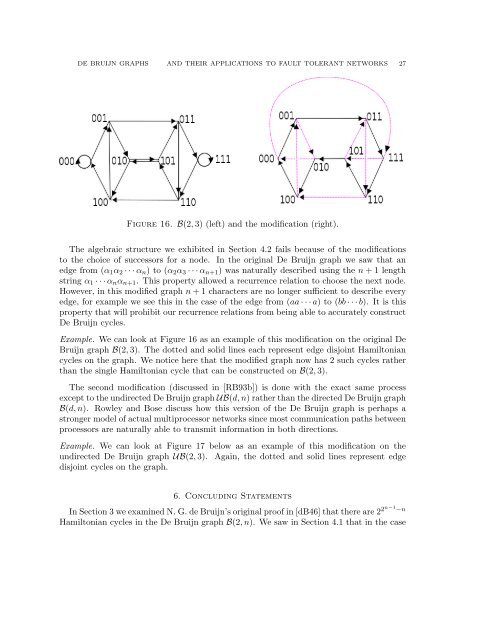26 JOEL BAKER5. <strong>De</strong> <strong>Bruijn</strong> ModificationsWe have now seen a variety of modifications <strong>to</strong> <strong>De</strong> <strong>Bruijn</strong> graphs. One particularlysimple modification described in Section 2 was the undirected version of <strong>De</strong> <strong>Bruijn</strong> graphs.In Section 3 we saw a generalized version of <strong>De</strong> <strong>Bruijn</strong> graphs called a T-net, <strong>and</strong> in Section4 we examined modifications which result from removing a set of nodes from B(2, n). Inthis section we will consider a few more variants.5.1. The Q n Cycle. This modification is unders<strong>to</strong>od more naturally through the idea of<strong>De</strong> <strong>Bruijn</strong> sequences, rather than through <strong>De</strong> <strong>Bruijn</strong> graphs. At the end of N.G. de <strong>Bruijn</strong>’spaper [dB46], he presents a problem analogous <strong>to</strong> that of counting <strong>De</strong> <strong>Bruijn</strong> sequencesas discussed in Section 3. He introduces the following sequence which has some uniqueproperties.<strong>De</strong>finition 21. A n-tuple is said <strong>to</strong> be admissible if no two consecutive digits are thesame. A Q n cycle is a string with alphabet {0,1,2} in which every admissible n-tupleoccurs exactly once in the string.Example. We see that [0,1,2,0,1,0,2,0,2,1,2,1] is a sequence where each admissible 3-tupleoccurs exactly once <strong>and</strong> thus it fits the criteria <strong>to</strong> be a Q 3 cycle.We see that like <strong>De</strong> <strong>Bruijn</strong> sequences, Q n cycles require each valid n-tuple <strong>to</strong> occur.However, unlike the <strong>De</strong> <strong>Bruijn</strong> sequences presented in [dB46], these revised sequences havea different validity requirement <strong>and</strong> they also use the alphabet {0,1,2} instead of {0,1}.These cycles do still have a closed formula; In [dB46], <strong>De</strong> <strong>Bruijn</strong> gives that the number ofQ n cycles is3 · 2 3·2n−2 −n−1 .This proof here is analogous <strong>to</strong> the proof presented in Section 3 of Theorem 1.5.2. Rowley <strong>and</strong> Bose Modifications. Rowley <strong>and</strong> Bose cover two additional types ofgraphs in <strong>their</strong> study of fault <strong>to</strong>lerance. The first is discussed in [RB91] <strong>and</strong> it is createdby removing some of the edges <strong>and</strong> adding them back in other places in order <strong>to</strong> allow thegraph <strong>to</strong> have d Hamil<strong>to</strong>nian cycles instead of the d − 1 in st<strong>and</strong>ard <strong>De</strong> <strong>Bruijn</strong> graphs. Thesecond graph is discussed in [RB93b], <strong>and</strong> is an undirected version of the first.Rowley <strong>and</strong> Bose give a lengthy description of the procedure for the first modificationin [RB91] that will not be presented here. However we will briefly outline the process. Inthe procedure, every self loop is removed <strong>and</strong> also exactly one edge in every pair of edgesof the form (abab · · · )(baba · · · ) for a ≠ b. Then, in order <strong>to</strong> preserve the in-degree <strong>and</strong>out-degree of the nodes, some edges of the form (aa · · · )(bb · · · ) <strong>and</strong> also (abab · · · )(cc · · · )are added.The new graph will maintain the in-degree <strong>and</strong> out-degree of the original <strong>De</strong> <strong>Bruijn</strong> graphB(d, n) <strong>and</strong> more importantly will allow us <strong>to</strong> construct d Hamil<strong>to</strong>nian cycles on each graphinstead of merely d − 1. This modification is motivated by the practical application of <strong>De</strong><strong>Bruijn</strong> graphs where self loops would be unimportant but better connectivity is. However,through it we lose some of the algebraic structure that was exhibited in the st<strong>and</strong>ard <strong>De</strong><strong>Bruijn</strong> graphs.
DE BRUIJN GRAPHS AND THEIR APPLICATIONS TO FAULT TOLERANT NETWORKS 27Figure 16. B(2, 3) (left) <strong>and</strong> the modification (right).The algebraic structure we exhibited in Section 4.2 fails because of the modifications<strong>to</strong> the choice of successors for a node. In the original <strong>De</strong> <strong>Bruijn</strong> graph we saw that anedge from (α 1 α 2 · · · α n ) <strong>to</strong> (α 2 α 3 · · · α n+1 ) was naturally described using the n + 1 lengthstring α 1 · · · α n α n+1 . This property allowed a recurrence relation <strong>to</strong> choose the next node.However, in this modified graph n + 1 characters are no longer sufficient <strong>to</strong> describe everyedge, for example we see this in the case of the edge from (aa · · · a) <strong>to</strong> (bb · · · b). It is thisproperty that will prohibit our recurrence relations from being able <strong>to</strong> accurately construct<strong>De</strong> <strong>Bruijn</strong> cycles.Example. We can look at Figure 16 as an example of this modification on the original <strong>De</strong><strong>Bruijn</strong> graph B(2, 3). The dotted <strong>and</strong> solid lines each represent edge disjoint Hamil<strong>to</strong>niancycles on the graph. We notice here that the modified graph now has 2 such cycles ratherthan the single Hamil<strong>to</strong>nian cycle that can be constructed on B(2, 3).The second modification (discussed in [RB93b]) is done with the exact same processexcept <strong>to</strong> the undirected <strong>De</strong> <strong>Bruijn</strong> graph UB(d, n) rather than the directed <strong>De</strong> <strong>Bruijn</strong> graphB(d, n). Rowley <strong>and</strong> Bose discuss how this version of the <strong>De</strong> <strong>Bruijn</strong> graph is perhaps astronger model of actual multiprocessor networks since most communication paths betweenprocessors are naturally able <strong>to</strong> transmit information in both directions.Example. We can look at Figure 17 below as an example of this modification on theundirected <strong>De</strong> <strong>Bruijn</strong> graph UB(2, 3). Again, the dotted <strong>and</strong> solid lines represent edgedisjoint cycles on the graph.6. Concluding StatementsIn Section 3 we examined N. G. de <strong>Bruijn</strong>’s original proof in [dB46] that there are 2 2n−1 −nHamil<strong>to</strong>nian cycles in the <strong>De</strong> <strong>Bruijn</strong> graph B(2, n). We saw in Section 4.1 that in the case
















